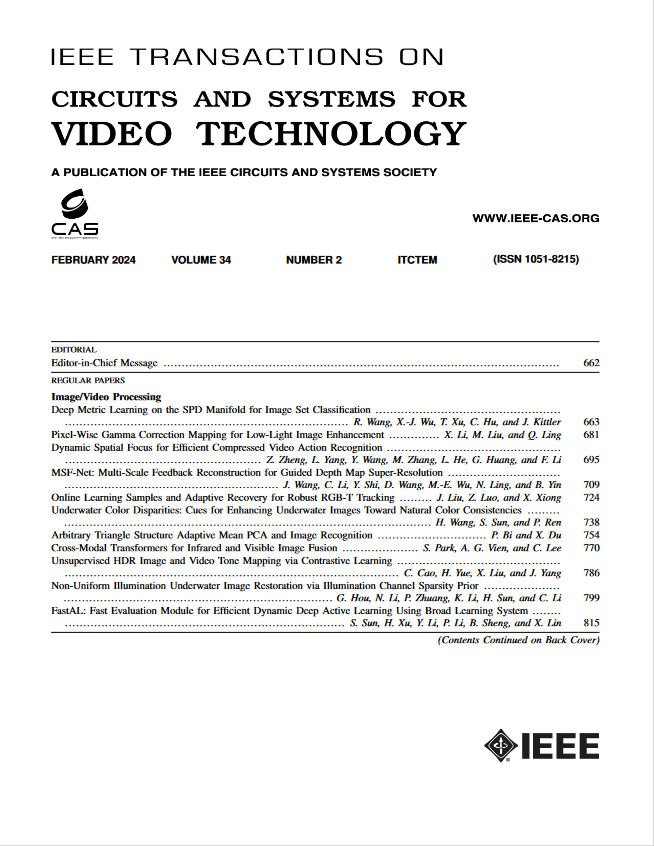自适应闭塞感知网络在闭塞人群再识别中的应用
IF 8.3
1区 工程技术
Q1 ENGINEERING, ELECTRICAL & ELECTRONIC
IEEE Transactions on Circuits and Systems for Video Technology
Pub Date : 2024-12-31
DOI:10.1109/TCSVT.2024.3524555
引用次数: 0
摘要
由于遮挡物的一些基本特征受到障碍物或其他行人的干扰,遮挡物的再识别是一项具有挑战性的任务。多粒度局部特征提取与识别可以有效提高遮挡下ReID的精度。然而,手工分割局部特征的方法会导致特征不匹配。基于姿态估计的特征对齐通常会忽略非身体细节(例如,手袋、背包等),同时增加模型的复杂性。为了解决上述挑战,我们提出了一种新的自适应闭塞感知网络(AOANet),该网络主要由两个模块组成,即自适应位置提取器(APE)和闭塞感知模块(OAM)。为了自适应提取人体部位的特征,APE在注意机制和关键点特征的引导下,对多粒度特征的表示进行了优化。为了进一步感知被遮挡的区域,通过自适应计算身体部位的遮挡权重来发展OAM。这些权重可以突出未遮挡的部分,抑制遮挡的部分,从而提高遮挡情况下的精度。大量的实验结果证实了我们的方法在MSMT17、DukeMTMC-reID、Market-1501、occlded - duke和occlded - reid数据集上的优势。对比结果表明,该方法优于同类方法。特别是在Occluded-Duke数据集上,我们的方法获得了70.6%的mAP和81.2%的Rank-1准确率。本文章由计算机程序翻译,如有差异,请以英文原文为准。
Adaptive Occlusion-Aware Network for Occluded Person Re-Identification
Occluded person re-identification (ReID) is a challenging task due to some of the essential features are interfered by obstacles or other pedestrians. Multi-granularity local feature extraction and recognition can effectively improve the accuracy of ReID under occlusion. However, manual segmentation methods for local features can lead to feature misalignment. Feature alignment based on pose estimation often ignores non-body details (e.g., handbags, backpacks, etc.) while increasing the complexity of the model. To address the above challenges, we propose a novel Adaptive Occlusion-Aware Network (AOANet), which mainly consists of two modules, the Adaptive Position Extractor (APE) and the Occlusion Awareness Module (OAM). In order to adaptively extract distinguishing features of body parts, APE optimizes the representation of multi-granularity features by the guidance of attention mechanism and keypoint features. To further perceive the occluded region, the OAM is developed by adaptively calculating the occlusion weights for body parts. These weights can lead to highlighting the non-occluded parts and suppressing the occluded parts, which in turn improves the accuracy in the occluded situation. Extensive experimental results confirm the advantages of our method on the MSMT17, DukeMTMC-reID, Market-1501, Occluded-Duke and Occluded-ReID datasets. The comparative results demonstrate that our method outperforms comparable methods. Especially on the Occluded-Duke dataset, our method achieved 70.6% mAP and 81.2% Rank-1 accuracy.
求助全文
通过发布文献求助,成功后即可免费获取论文全文。
去求助
来源期刊
CiteScore
13.80
自引率
27.40%
发文量
660
审稿时长
5 months
期刊介绍:
The IEEE Transactions on Circuits and Systems for Video Technology (TCSVT) is dedicated to covering all aspects of video technologies from a circuits and systems perspective. We encourage submissions of general, theoretical, and application-oriented papers related to image and video acquisition, representation, presentation, and display. Additionally, we welcome contributions in areas such as processing, filtering, and transforms; analysis and synthesis; learning and understanding; compression, transmission, communication, and networking; as well as storage, retrieval, indexing, and search. Furthermore, papers focusing on hardware and software design and implementation are highly valued. Join us in advancing the field of video technology through innovative research and insights.

 求助内容:
求助内容: 应助结果提醒方式:
应助结果提醒方式:


